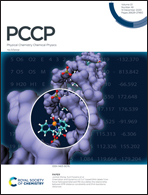Computational insights into the sorption mechanism of environmental contaminants by carbon nanoparticles through molecular dynamics simulation and density functional theory†
Abstract
Carbon nanomaterials like carbon nanotubes (CNTs), graphene or graphene oxide (GO) could significantly enhance contaminant sorption in aqueous solutions, and offer a promising opportunity in water and air purification for the removal of environmental contaminants. Although the sorption of environmental contaminants by carbon nanoparticles has been reported in many studies, the knowledge regarding their molecular mechanism at the atomic level is still very limited. In this study, we integrate density functional theory (DFT) calculation, fully atomistic molecular dynamics (MD) simulation and binding energy calculation to investigate the sorption mechanism of environmental contaminants by carbon nanoparticles. We proposed that CNTs and graphene–carbon nanoparticles can be used for the sorption of hydrophobic contaminants, and the GO–carbon nanoparticles are more suitable for the sorption of polar and ionic contaminants, and we believe that the results would have important implications for the future application of carbon nanoparticles in environmental pollution cleanup.



 Please wait while we load your content...
Please wait while we load your content...